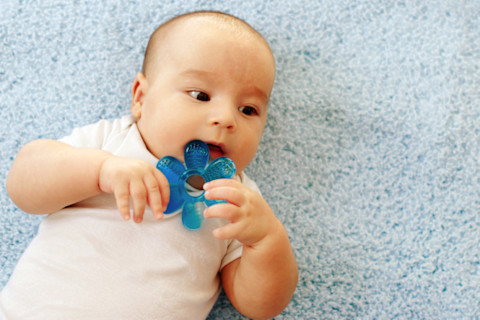Teething Baby? Here Are The Safest & Most Effective Treatments To Try

A baby’s first tooth coming in is an exciting milestone, but it can also be a trying time. Teething is an uncomfortable and confusing experience for children, and as the teeth push toward the surface and through the gums, they cause inflammation, pain, and swelling—which can wreak havoc on the lives of both children and parents.
Although it can be difficult to watch your baby go through this ordeal, teething is a natural and necessary part of growing. Luckily, there are some ways to ease the pain and a ton of products on the market to help calm teething babies. One thing to watch out for: Some of these product may be choking hazards or contain harmful ingredients. Here's the lowdown on how to safely and effectively soothe your baby's sore mouth.
The basics of teething: How to know when your baby is teething and simple solutions for pain.
If your baby is around four to six months old and is suddenly irritable, having trouble sleeping, and gnawing on everything in their reach, get ready—you probably have a teething baby on your hands. Check their gums for redness and swelling to confirm. You might also notice a marked increase in their drooling, due to their newfound attention to gnawing on toys which can stimulate saliva production. Be sure to wipe away the excess drool frequently and keep the chin dry to avoid skin irritation and rashes, which will only make baby more uncomfortable. The Mayo Clinic warns to always see a doctor if your baby has a fever, diarrhea, or vomiting. These may be symptoms of more serious illnesses and are not due to teething.

But, in general, there's no need to run out to the store or call the doctor at the first telltale signs of teething. In fact, it might not even require a trip to the store at all. Many parents swear by items you probably already have on hand to help soothe the ache.
One free idea? Try applying soft counterpressure to the gums with your fingers. The compression may provide some short-term relief. Or, integrative doctor and mbg collective member, Amy Shah, M.D., recommends rubbing your babies gums with a soft damp washcloth. The interesting texture will stimulate the gums and create a massaging sensation. For an added numbing effect, place the washcloth in the refrigerator to cool first or try a chilled spoon. If your baby has started eating solids, Dr. Shah suggests giving them cold fruits or vegetables like carrots and cucumbers to gnaw on (just make sure to always keep an eye on them while they're eating).
Teething necklaces
Teething babies love to grab and chew on jewelry. Trendy teething necklaces made for mom or dad to wear offer a safe, easily accessible, and soft alternative. These necklaces are wearable teething toys designed to look like jewelry cute enough to wear long after you've survived the teething phase. Consider it a gift to your baby and yourself. The beads, usually textured silicone shapes, are specifically made to entertain and soothe teething babies. An added bonus: Your baby can't drop the necklace to the floor like their toys, since it's around your neck, so fewer germs and less clean-up time.
Amber teething necklaces are another option you'll often see marketed as a teething solution. These necklaces are meant to be worn by the baby and are touted for their healing properties. The beads contain Baltic amber (or at least they are advertised to), which when warmed by body heat is believed to release a soothing substance called succinic acid1. Unfortunately, these necklaces are not only ineffective, they can be dangerous. Heated amber does release succinic acid, but the small amount of succinic acid released by wearing this necklace would likely not be enough to produce any anti-inflammatory effects. Also, the American Pediatric Association warns that these necklaces may pose a strangulation risk and recommends that babies should not wear anything around their neck. Children should especially never wear amber teething necklaces unsupervised or while sleeping.
Another risk: The child may be tempted to chew on the small amber beads, presenting a choking hazard. A study2 looking at the strangulation and choking risk of 15 commercially available amber necklaces found that 50 percent failed standardized strangulation testing and 80 percent failed choking tests. The dangers of amber teething necklaces seem to far outweigh any small benefit they might have, so it's best to stick to the tried-and-true methods mentioned above.
Teething tablets
You may have heard of teething tablets for pain relief. These homeopathic over-the-counter pills are supposed to soothe irritation and discomfort caused by teething. Teething tablets are meant to dissolve in the baby’s mouth and offer anti-inflammatory benefits. Unfortunately, seizures, difficulty breathing, and other scary symptoms have been reported after the use of teething tablets. In 2017, the FDA issued a warning that some available tablets contain toxic levels of the ingredient belladonna3 and recommended parents discard any teething tablets they may have. Subsequently, Hyland’s, one of the leading brands, discontinued their line of teething tablets. Although teething tablets are still available from some retailers, the FDA recommends using alternative methods, and again, it's best to stick to the basics.
Teething rings

Teething rings are a dependable and generally safe teething remedy. By chewing on these rings, babies can exert gentle pressure on their gums, which can be soothing. Teething rings can be found in a variety of materials, including wooden, BPA-free silicone, and fabric. The different materials offer unique sensations and are a matter of preference. Rings that feature multiple textured surfaces (think bump and bristles) may entertain your baby longer and distract from the pain. Look for teething rings that are small enough for baby to handle on their own but not so small they could choke on them. Try popping teething rings in the fridge for an added cooling effect; just be sure to check with the manufacturers that the material can go in the fridge. The Mayo Clinic advises never putting them in the freezer, though, as the temperature may be too extreme for babies.
Teething biscuits
Older babies who are already accustomed to solid foods might enjoy gumming on a teething biscuit to soothe sore gums. These soft wafers are especially helpful for babies that may not be eating as much due to their sore mouth. While gnawing at this "toy," your child will also be getting a snack. Be sure to supervise your child whenever they are eating, as small pieces of the biscuit could break off and cause your child to choke. Another thing to consider with teething biscuits is the sugar content. Just like adult teeth, baby teeth are susceptible to cavities, and the prolonged contact with super-sugary foods can be harmful to their new teeth.
Worried about raising a picky eater? Here's how to get your family to eat healthy.
